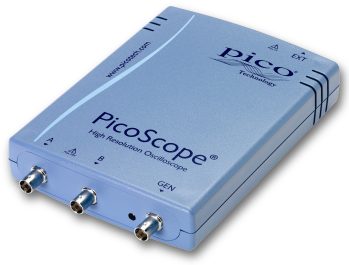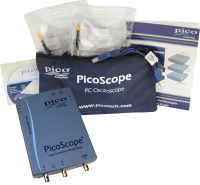|
PicoScope 4262 Zeer hoge resolutie |
 Met
16–bit resolutie, low noise en low distortion, heeft de
PicoScope 4262 de preciezie en eigenschappen die u nodig
heeft. Met
16–bit resolutie, low noise en low distortion, heeft de
PicoScope 4262 de preciezie en eigenschappen die u nodig
heeft.
• Twee kanelen
• 16–bit resolutie
• 10
MS/s sampling
• 5 MHz bandbreedte
• 16 MS buffer
memory
• Low–distortion signal generator
• Arbitrary
waveform generator
• USB powered
Low
distortion, low noise
The PicoScope 4262 is a
dual–channel, 16–bit very–high–resolution oscilloscope
(VHRO) with an integrated low–distortion signal generator.
With its 5 MHz bandwidth, it can easily analyse audio,
ultrasonic and vibration signals, characterise noise in
switched mode power supplies, measure distortion and perform
a wide range of precision measurement tasks.
Arbitrary waveform and function generator
The
PicoScope 4262 includes an integrated low–distortion signal
generator. As well as basic controls to set level, offset
and frequency, more advanced controls allow you to sweep
over a range of frequencies. Combined with the spectrum peak
hold option, this makes the PicoScope 4262 a powerful tool
for testing amplifier and filter responses.
The
PicoScope 4262 also includes a programmable arbitrary
waveform generator with a 4,096 sample buffer.
Wat krijgt u?

• PicoScope 4262 VHRO
• 2 x probe (x1/x10)
• beschermtas voor probes
• USB kabel
•
Gebruikershandleidingen
•
PicoScope 6
• Gratis software-updates
• 5
jaar garantie |
And it’s a high–performance spectrum analyzer
too
Thanks to the power of the supplied
PicoScope software you can also use the PicoScope 4262 as a
spectrum analyzer. When used as a spectrum analyzer,
PicoScope provides 11 automated measurements such as IMD,
THD and SFDR that makes it easier and faster for you to
accomplish your task. The performance of the PicoScope 4262
when used as a spectrum analyzer is so good that it rivals
many dedicated audio analyzers and dynamic signal analyzers
costing several times the price.
The
trend–busting oscilloscope
Most digital
oscilloscopes have been designed for viewing fast digital
signals. The trend has been to use new technology solely to
increase sampling rate and bandwidth. With the PicoScope
4262 we have focused on what’s important for measuring
analogue signals: increasing the resolution, improving
dynamic range, and reducing noise and distortion.
Why pay more?
At Pico we don’t do
“optional extras”. Other companies may think that you should
pay for high–end features such as mask limit testing, serial
decoding, advanced triggering, automatic measurements, math
channels, XY mode, digital filtering and segmented memory.
We don’t. When you buy a PicoScope Very–High–Resolution
Oscilloscope everything is included in the price.
The precision and performance you need
The PicoScope 4262 is a full–featured oscilloscope that can
also be used as a high–performance spectrum anazlyer, signal
generator and arbitrary waveform generator. With two
channels, 16–bit resolution, 10 MS/s sampling, 16 MS buffer
memory and 5 MHz bandwidth the PicoScope 4262 gives you the
precision and performance you need at a price you can
afford.
|
Oscilloscope — Vertical |
Bandwidth
±20 mV range
±10 mV range |
5 MHz
4 MHz
3 MHz |
|
Bandwidth limiter |
200 kHz, switchable |
Rise time (calculated)
±20 mV range
±10 mV
range |
70 ns
88 ns
117 ns |
|
Input Channels |
2 |
|
Vertical resolution |
16 bits |
|
Enhanced vertical resolution |
20 bits |
DC accuracy (% of full scale)
±50 mV range
±20 mV
range
±10 mV range |
±0.25%
±0.5%
±1%
±2% |
|
Input sensitivity |
2 mV/div to 4 V/div (10 vertical
divisions) |
|
Input characteristics |
1 MΩ ±2% in parallel with 15 pF ±2 pF |
|
Input type |
Single–ended, BNC connector |
|
Input coupling |
Software selectable AC/DC |
|
Input ranges (full scale) |
±10 mV to ±20 V in 11 ranges |
|
Overvoltage protection |
±50 V (DC+AC peak) |
|
Oscilloscope — Horizontal |
|
Maximum sampling rate (single shot) |
10 MS/s |
Maximum sampling rate
(continuous
streaming mode)
Using PicoScope
Using the
SDK |
10 MS/s
10 MS/s one channel
(PC dependent)
6.7 MS/s two channels (PC
dependent) |
|
Buffer memory |
16 MS |
Waveform buffer
Using PicoScope
Using the SDK |
Up to 10,000 waveforms
Up to
32,768 waveforms |
|
Timebase ranges |
1 µs/div to 5000 s/div |
|
Timebase accuracy |
±50 ppm |
|
Sample jitter |
< 10 ps RMS |
|
Dynamic Performance (typical) |
|
Crosstalk |
> 50,000:1 |
|
Total harmonic distortion |
-95 dB typical @ 10 kHz, -1 dBfs input |
|
SFDR |
102 dB typical @ 10 kHz, -1 dBfs input |
|
Pulse response |
< 1% overshoot on all ranges |
|
Bandwidth flatness |
±0.2 dB (DC to full bandwidth) |
|
Noise |
8.5 µV RMS (on most sensitive range) |
|
Triggers (Channels A and B) |
|
Source |
Any input channel |
|
Trigger modes |
None, auto, repeat, single, rapid
(segmented memory) |
|
Basic trigger types |
Rising, falling |
|
Advanced triggers |
Edge: rising, falling
or dual edge with adjustable hysteresis
Window: signal enters or
exits a user–defined voltage range
Pulse width: a negative or
positive pulse is wider or narrower than a
set width, or inside/outside a range of
widths
Window pulse width:
signal is inside or outside a voltage range
for a set time
Dropout:
signal does not cross a voltage threshold
for at least a set time
Window
dropout: signal does not enter or
exit a voltage range for at least a set time
Interval: time between two
edges is greater or less than a set time, or
inside/outside a time range
Logic:
arbitrary logic state of Channels A, B and
EXT matches a user–defined pattern
Runt pulse: signal crosses
one voltage threshold and returns without
crossing the other |
|
Trigger sensitivity |
Digital triggering provides 1 LSB
accuracy up to full bandwidth of scope |
|
Maximum pre–trigger capture |
Up to 100% of capture size |
|
Maximum post–trigger delay |
Up to 4 billion samples |
|
Trigger re–arm time |
< 10 µs on fastest timebase |
|
External Trigger |
|
Trigger types |
Edge, pulse width, dropout, interval,
logic, delayed |
|
Input characteristics |
1 MΩ ±2% in parallel with 15 pF ±2 pF |
|
Input type |
Rear panel BNC connector |
|
Threshold range |
±5 V and ±500 mV, DC coupled |
|
Trigger sensitivity |
25 mV p–p at 1 MHz, typical |
|
DC accuracy |
±1% |
|
Bandwidth |
5 MHz |
|
Overvoltage protection |
±50 V |
|
Spectrum Analyser |
|
Frequency range |
DC to 5 MHz |
|
Windowing functions |
Rectangular, Gaussian, triangular,
Blackman, Blackman–Harris, Hamming, Hann,
flat–top |
|
Display modes |
Magnitude, peak hold, average |
|
Number of
FFT
points |
selectable from 128 to 1 million in
powers of 2 |
|
Signal Generator |
|
Standard output signals |
Sine, square, triangle, DC voltage,
ramp, sinc, Gaussian, half–sine, white
noise,
PRBS |
|
Standard signal frequency |
DC to 20 kHz |
|
Output frequency accuracy |
±50 ppm |
|
Output frequency resolution |
< 0.01 Hz |
|
Output voltage range |
±1 V (into high–impedance load) |
|
Offset voltage adjustment |
100 µV steps (within overall ±1 V range) |
|
DC accuracy |
±0.5% of full scale |
|
Amplitude flatness |
< 0.1 dB to 20 kHz, typical |
|
SFDR |
102 dB typical @ 10 kHz, -1 dBfs input |
|
Connector type |
Front panel BNC |
|
Output characteristics |
600 Ω |
|
Overvoltage protection |
±10 V |
|
Sweep modes |
Up, down, dual with selectable frequency
and sweep time |
|
Arbitrary Waveform Generator |
|
Update rate |
192 kS/s |
|
Buffer size |
4,096 samples |
|
Resolution |
16 bits |
|
Bandwidth |
20 kHz |
|
Rise time (10% to 90%) |
11 µs, typical |
|
PC Requirements |
|
minimum |
Processor: 1 GHz
Memory: 512 miB
Free disk space: 32–bit: 600 MB,
64–bit: 1.5 GB
Operating system:
32– or 64–bit edition of microsoft Windows
XP (SP3), Vista, Windows 7 or Windows 8 (not
Windows RT)
Ports: USB
2.0 compliant port |
|
Recommended |
Processor: 1 GHz
Memory: 512 miB
Free disk space: 32–bit: 850 MB,
64–bit: 2 GB
Operating system:
32– or 64–bit edition of microsoft Windows
XP (SP3), Vista, Windows 7 or Windows 8 (not
Windows RT)
Ports: USB
2.0 or 3.0 compliant port |
|
Environmental |
Operating environment
Temperature range
Humidity |
0 °C to 45 °C (20 °C to 30 °C for
quoted accuracy)
5% to 80% RH,
non–condensing |
Storage environment
Temperature range
Humidity |
-20 °C to +60°C
5% to 95% RH,
non–condensing |
|
Physical Properties |
|
Dimensions (including connectors) |
210 x 135 x 40 mm (approx 8.2 x 5.3 x
1.5 in) |
|
Weight |
< 500 g (approx 1.1 lb) |
|
Software |
|
PicoScope 6 for Windows |
PicoScope 6 is your complete test and
measurement lab in one application. Features
include:
Capture modes:
oscilloscope, spectrum and persistence.
Channel maths: calculate the
sum, difference, product, inverse or create
your own custom function using standard
arithmetic, exponential and trigonometric
functions.
Mask limiting testing:
pass/fail, failure count, total count.
serial Decoding: decode data
from a serial bus such as I²C.
Automated measurements
Scope mode: AC
RMS,
true RMS, cycle time, DC average, duty
cycle, falling rate, fall time, frequency,
high pulse width, low pulse width, maximum,
minimum, peak–to–peak, rise time and rising
rate.
Spectrum mode:
frequency at peak, amplitude at peak,
average amplitude at peak, total power,
total harmonic distortion (THD % and THD
dB), total harmonic distortion plus noise
(THD+N), spurious-free dynamic range (SFDR),
signal+noise+distortion to signal+noise
ratio (SINAD), signal to noise ratio (SNR)
and intermodulation distortion (IMD).
Export data formats: comma
separated values (CSV), tab delimited (TXT),
windows bitmap (BMP), graphics interchange
format (GIF), portable network graphics
(PNG),
MATLAB 4 format (MAT).
Full details for PicoScope 6 |
|
Software development kit |
Includes drivers and example code for
various programming languages including C,
Excel, LabVIEW and Visual Basic.
Download SDK |
|
Language Support |
Software
PicoScope 6 |
Full support for:
English, Français, Deutsch, Italiano,
Español
Menus and dialogs only
for: 中文 (简体), 中文 (繁體), Čeština,
Dansk, suomi, Ελληνικά, Magyar, 한국어, 日本語,
Norsk, Polski, Português, română, Русский,
Svenska, Türkçe |
Documentation
User’s
guide |
English, Français, Deutsch,
Italiano, Español, 中文 |
|
General |
|
Data sheet |
English
中文 (简体),
Deutsch,
Español,
Français,
Italiano |
|
Additional hardware (supplied) |
2 x
mi007 probes, USB 2.0 cable, user
manuals, software CD–ROM |
|
PC interface |
USB 2.0 |
|
Power requirements |
Powered from USB port |
|
Compliance |
European EMC and LVD standards
FCC
Rules Part 15 Class A
RoHS compliant |
|
Total Satisfaction Guarantee |
In the event that this product does not
fully meet your requirements you can return
it for an exchange or refund. To claim, the
product must be returned in good condition
within 14 days. |
|
Warranty |
5 years |
|
|
 Met
16–bit resolutie, low noise en low distortion, heeft de
PicoScope 4262 de preciezie en eigenschappen die u nodig
heeft.
Met
16–bit resolutie, low noise en low distortion, heeft de
PicoScope 4262 de preciezie en eigenschappen die u nodig
heeft.
